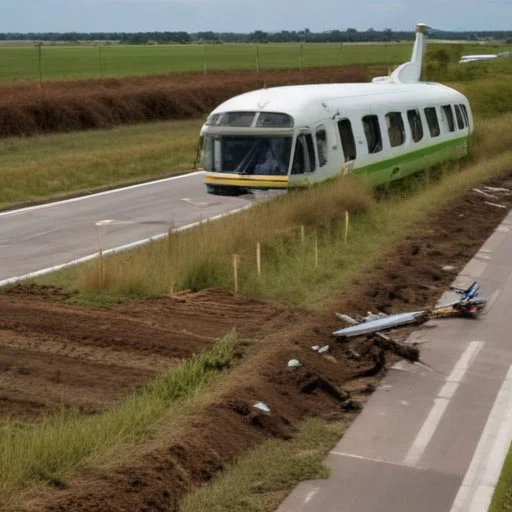VASP Flight 168, a Boeing 727-200, etched its name in the dark annals of Brazilian aviation history as one of the deadliest plane crashes of all time, claiming the lives of 128 innocent people on a fateful day in 1988. The ill-fated flight, which took off from São Luís, was bound for Fortaleza, but never reached its destination, instead meeting a catastrophic end in the small town of Pacatuba, Ceará, Brazil.
The crash of VASP Flight 168 marked a turning point in Brazil's aviation history, prompting a national outcry and a renewed focus on safety regulations. As the country's deadliest aviation disaster, it cast a long shadow, illuminating the vulnerabilities of the Brazilian air transport system and sparking widespread calls for reform.
On that tragic day, September 8, 1988, VASP Flight 168 departed São Luís's Marechal Cunha Machado International Airport, carrying 128 passengers and crew members. The Boeing 727-200, piloted by Captain José Antônio Rodrigues, was expected to touch down in Fortaleza's Pinto Martins International Airport, but fate had other plans.
At approximately 6:40 pm local time, the aircraft went down in a rural area near Pacatuba, about 30 kilometers from Fortaleza. The impact was catastrophic, with rescue teams arriving on the scene to find a trail of debris and destruction. The crash site was a testament to the horrors of the disaster, with bodies strewn about and personal belongings scattered across the landscape.
The investigation into the crash, led by the Brazilian Air Force and the National Transportation Safety Board (NTSB), revealed a combination of human error and technical failures as the probable causes of the disaster. The pilots' failure to follow standard operating procedures and a faulty altimeter were identified as primary contributing factors.
The crash of VASP Flight 168 left an indelible mark on the families and loved ones of the victims, many of whom were traveling to Fortaleza for business or leisure. The tragedy also had a profound impact on the local community, with many residents of Pacatuba still recalling the traumatic events of that day.
In the aftermath of the disaster, the Brazilian government and aviation authorities implemented sweeping reforms to improve safety standards and regulations. The crash of VASP Flight 168 served as a catalyst for change, leading to the creation of the Brazilian Airspace Control Agency (Agência Nacional de Aviação Civil - ANAC) and the adoption of more stringent safety protocols.
In conclusion, the tragic crash of VASP Flight 168 remains an indelible stain on Brazil's aviation history, a somber reminder of the devastating consequences of human error and technical failures. As we reflect on this dark chapter, we honor the memories of the victims and their families, while reaffirming our commitment to ensuring the safety of air travel for generations to come.
The crash of VASP Flight 168 had a profound impact on Brazilian culture, leading to a renewed focus on air safety and a deeper appreciation for the importance of rigorous safety protocols. The tragedy also sparked a national conversation about the role of government in ensuring public safety. In the years following the crash, Brazilians came together to support the families of the victims and to advocate for changes in aviation policy.
The tragedy also had a significant impact on the music world, as several popular Brazilian musicians were among the victims. The crash was commemorated in numerous songs, including "Chão de Estrelas" by Brazilian singer-songwriter Chico Buarque.
In the decades since the crash, VASP Flight 168 has become a cultural touchstone in Brazil, symbolizing the importance of safety and responsibility in all aspects of life.

The economic impact of the VASP Flight 168 crash was significant, with the Brazilian government facing substantial costs related to the rescue and recovery efforts, as well as compensation for the families of the victims.
The crash also had a major impact on the Brazilian airline industry, leading to increased scrutiny of safety protocols and a renewed focus on compliance with international safety standards. In the years following the crash, the industry invested heavily in safety improvements, including the adoption of new technologies and the implementation of more stringent safety procedures.
The crash also had a broader economic impact, as it led to increased awareness of the importance of safety in all sectors of the economy. This, in turn, led to increased investment in safety research and development, as well as the creation of new safety regulations and standards.
The crash of VASP Flight 168 occurred during a period of significant political and economic change in Brazil. The country was in the midst of a transition from military rule to democracy, and the crash highlighted the need for greater transparency and accountability in government.
The crash also had significant geopolitical implications, as it led to increased cooperation between Brazil and other countries on aviation safety issues. The incident highlighted the importance of international cooperation in ensuring air safety, and it paved the way for greater collaboration on safety issues in the years to come.

Historians have interpreted the crash of VASP Flight 168 in a number of ways, with some viewing it as a turning point in Brazilian aviation history. The incident marked a shift towards greater emphasis on safety and accountability in the industry, and it led to significant changes in the way that air safety was regulated and enforced.
Other historians have seen the crash as a symbol of the broader social and economic changes that were taking place in Brazil during the late 1980s. The incident highlighted the growing importance of air travel in Brazil, as well as the need for greater investment in safety infrastructure and research.
Still, others have viewed the crash as a human tragedy, one that underscored the importance of compassion and empathy in the face of disaster.
The crash of VASP Flight 168 led to significant advances in aviation technology, as investigators sought to understand the causes of the tragedy and to develop new safety protocols to prevent similar incidents in the future.
One of the key technological changes to emerge from the crash was the widespread adoption of improved altimeter systems, which were designed to reduce the risk of human error in altitude measurement. This, in turn, led to the development of more sophisticated automation systems, which were capable of detecting and responding to potential safety threats more quickly and accurately.
The crash also led to increased investment in safety research and development, as scientists and engineers sought to develop new technologies and materials that could improve the safety of air travel. This, in turn, paved the way for the development of newer, safer aircraft designs, as well as more advanced safety features and systems.